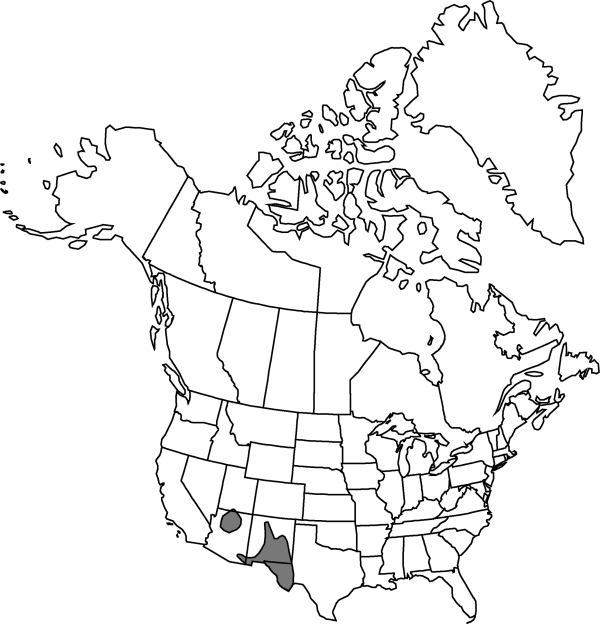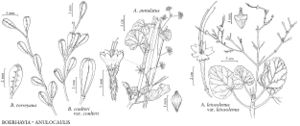Difference between revisions of "Boerhavia torreyana"
Contr. U.S. Natl. Herb. 12: 385. 1909.
FNA>Volume Importer |
imported>Volume Importer |
||
| (7 intermediate revisions by 2 users not shown) | |||
| Line 7: | Line 7: | ||
|year=1909 | |year=1909 | ||
}} | }} | ||
| − | |basionyms={{Treatment/ID/ | + | |special_status={{Treatment/ID/Special_status |
| + | |code=F | ||
| + | |label=Illustrated | ||
| + | }} | ||
| + | |basionyms={{Treatment/ID/Basionym | ||
|name=Boerhavia spicata var. torreyana | |name=Boerhavia spicata var. torreyana | ||
|authority=S. Watson | |authority=S. Watson | ||
| + | |rank=variety | ||
| + | |publication_title=Proc. Amer. Acad. Arts | ||
| + | |publication_place=24: 70. 1889 (as Boerhaavia) | ||
}} | }} | ||
|synonyms= | |synonyms= | ||
| Line 19: | Line 26: | ||
}}<!-- | }}<!-- | ||
| − | --><span class="statement" id="st- | + | --><span class="statement" id="st-undefined" data-properties=""><b>Herbs,</b> annual; taproot tapered, soft or ± woody. <b>Stems</b> prostrate or decumbent-ascending, usually profusely branched throughout, 10–80 dm, minutely puberulent with flat hairs, usually also with spreading hairs, sometimes also glandular basally, glabrous distally. <b>Leaves</b> mostly in basal 1/2; larger leaves with petiole 7–20 mm, blade oblong-ovate, oval, ovate, or lanceolate, 20–45 × 9–25 mm (distal leaves usually shorter, proportionately narrower), adaxial surface glabrous or sparsely and minutely puberulent, abaxial surface paler than adaxial, glabrous or minutely puberulent, sometimes glandular, neither surface punctate or both punctate with minute clusters of brown cells, base truncate, rounded, or obtuse, margins sinuate to sinuate-crisped, apex round to obtuse or acute. <b>Inflorescences</b> terminal and axillary, forked ca. 3–6 times unequally, diffuse, usually with sticky internodal bands; branches strongly ascending, terminating in spicate or racemose flower clusters, axis 10–40 mm. <b>Flowers</b>: pedicel 0.1–1.7 mm; bract at base of perianth usually soon deciduous, usually 1, broadly lanceolate to lance-attenuate, 0.5–1.2 mm; perianth whitish to purplish pink, campanulate distal to constriction, 1–1.3 mm; stamens 2, slightly exserted. <b>Fruits</b> 2–12 per cluster, usually remotely spaced, sometimes about 1/2 overlapped, occasionally ± paired, straw colored to grayish tan, narrowly obovoid, 2.2–3(–3.8) × 0.9–1.1 (–1.3) mm (l/w: [1.9–]2.2–3.1), apex round or round-obtuse, glabrous; ribs 5, obtuse or round-obtuse, strongly rugose near sulci; sulci 0.5–1 times as wide as base of ribs, not or slightly rugose, papillate. <b>2n</b> = 52.</span><!-- |
-->{{Treatment/Body | -->{{Treatment/Body | ||
| + | |phenology=Flowering mid summer and early fall. | ||
|habitat=Sandy or rocky soils in deserts or arid grasslands | |habitat=Sandy or rocky soils in deserts or arid grasslands | ||
|elevation=600-1300 m | |elevation=600-1300 m | ||
|distribution=Ariz.;N.Mex.;Tex.;Utah;Mexico (Chihuahua;Coahuila);South America (introduced in Argentina). | |distribution=Ariz.;N.Mex.;Tex.;Utah;Mexico (Chihuahua;Coahuila);South America (introduced in Argentina). | ||
| − | |discussion=<p>Boerhavia torreyana occurs in the Chihuahuan Desert, extends north of the Mogollon Rim in arid sites, and barely enters southeastern Arizona. The slender, remotely flowered inflorescences and the papillate sulci distinguish this from other spicate species. There were fewer ants and aphids on plants of B. torreyana (reported as B. spicata) with intact internodal bands as compared to those whose bands had been experimentally altered (Y. McClelan and W. J. Boecklen 1993).</p> | + | |discussion=<p><i>Boerhavia torreyana</i> occurs in the Chihuahuan Desert, extends north of the Mogollon Rim in arid sites, and barely enters southeastern Arizona. The slender, remotely flowered inflorescences and the papillate sulci distinguish this from other spicate species. There were fewer ants and aphids on plants of <i>B. torreyana</i> (reported as <i>B. spicata</i>) with intact internodal bands as compared to those whose bands had been experimentally altered (Y. McClelan and W. J. Boecklen 1993).</p> |
|tables= | |tables= | ||
|references= | |references= | ||
| Line 34: | Line 42: | ||
-->{{#Taxon: | -->{{#Taxon: | ||
name=Boerhavia torreyana | name=Boerhavia torreyana | ||
| − | |||
|authority=(S. Watson) Standley | |authority=(S. Watson) Standley | ||
|rank=species | |rank=species | ||
| Line 41: | Line 48: | ||
|basionyms=Boerhavia spicata var. torreyana | |basionyms=Boerhavia spicata var. torreyana | ||
|family=Nyctaginaceae | |family=Nyctaginaceae | ||
| + | |phenology=Flowering mid summer and early fall. | ||
|habitat=Sandy or rocky soils in deserts or arid grasslands | |habitat=Sandy or rocky soils in deserts or arid grasslands | ||
|elevation=600-1300 m | |elevation=600-1300 m | ||
| Line 47: | Line 55: | ||
|publication title=Contr. U.S. Natl. Herb. | |publication title=Contr. U.S. Natl. Herb. | ||
|publication year=1909 | |publication year=1909 | ||
| − | |special status= | + | |special status=Illustrated |
| − | |source xml=https:// | + | |source xml=https://bitbucket.org/aafc-mbb/fna-data-curation/src/2e0870ddd59836b60bcf96646a41e87ea5a5943a/coarse_grained_fna_xml/V4/V4_40.xml |
|genus=Boerhavia | |genus=Boerhavia | ||
|species=Boerhavia torreyana | |species=Boerhavia torreyana | ||
| − | |||
| − | |||
| − | |||
| − | |||
| − | |||
| − | |||
| − | |||
| − | |||
| − | |||
| − | |||
| − | |||
| − | |||
| − | |||
| − | |||
| − | |||
| − | |||
| − | |||
| − | |||
| − | |||
| − | |||
| − | |||
| − | |||
| − | |||
| − | |||
| − | |||
| − | |||
| − | |||
| − | |||
| − | |||
| − | |||
| − | |||
| − | |||
| − | |||
| − | |||
| − | |||
| − | |||
| − | |||
| − | |||
| − | |||
| − | |||
| − | |||
| − | |||
| − | |||
| − | |||
| − | |||
| − | |||
| − | |||
| − | |||
| − | |||
| − | |||
| − | |||
| − | |||
| − | |||
| − | |||
| − | |||
| − | |||
| − | |||
| − | |||
}}<!-- | }}<!-- | ||
-->[[Category:Treatment]][[Category:Boerhavia]] | -->[[Category:Treatment]][[Category:Boerhavia]] | ||
Latest revision as of 21:58, 5 November 2020
Herbs, annual; taproot tapered, soft or ± woody. Stems prostrate or decumbent-ascending, usually profusely branched throughout, 10–80 dm, minutely puberulent with flat hairs, usually also with spreading hairs, sometimes also glandular basally, glabrous distally. Leaves mostly in basal 1/2; larger leaves with petiole 7–20 mm, blade oblong-ovate, oval, ovate, or lanceolate, 20–45 × 9–25 mm (distal leaves usually shorter, proportionately narrower), adaxial surface glabrous or sparsely and minutely puberulent, abaxial surface paler than adaxial, glabrous or minutely puberulent, sometimes glandular, neither surface punctate or both punctate with minute clusters of brown cells, base truncate, rounded, or obtuse, margins sinuate to sinuate-crisped, apex round to obtuse or acute. Inflorescences terminal and axillary, forked ca. 3–6 times unequally, diffuse, usually with sticky internodal bands; branches strongly ascending, terminating in spicate or racemose flower clusters, axis 10–40 mm. Flowers: pedicel 0.1–1.7 mm; bract at base of perianth usually soon deciduous, usually 1, broadly lanceolate to lance-attenuate, 0.5–1.2 mm; perianth whitish to purplish pink, campanulate distal to constriction, 1–1.3 mm; stamens 2, slightly exserted. Fruits 2–12 per cluster, usually remotely spaced, sometimes about 1/2 overlapped, occasionally ± paired, straw colored to grayish tan, narrowly obovoid, 2.2–3(–3.8) × 0.9–1.1 (–1.3) mm (l/w: [1.9–]2.2–3.1), apex round or round-obtuse, glabrous; ribs 5, obtuse or round-obtuse, strongly rugose near sulci; sulci 0.5–1 times as wide as base of ribs, not or slightly rugose, papillate. 2n = 52.
Phenology: Flowering mid summer and early fall.
Habitat: Sandy or rocky soils in deserts or arid grasslands
Elevation: 600-1300 m
Distribution

Ariz., N.Mex., Tex., Utah, Mexico (Chihuahua, Coahuila), South America (introduced in Argentina).
Discussion
Boerhavia torreyana occurs in the Chihuahuan Desert, extends north of the Mogollon Rim in arid sites, and barely enters southeastern Arizona. The slender, remotely flowered inflorescences and the papillate sulci distinguish this from other spicate species. There were fewer ants and aphids on plants of B. torreyana (reported as B. spicata) with intact internodal bands as compared to those whose bands had been experimentally altered (Y. McClelan and W. J. Boecklen 1993).
Selected References
None.
